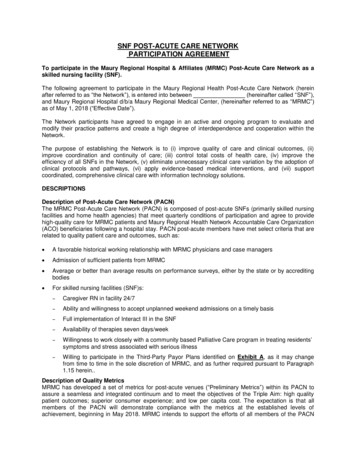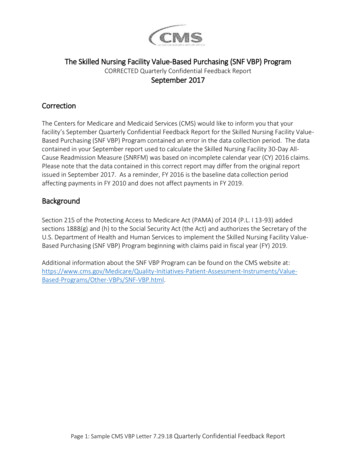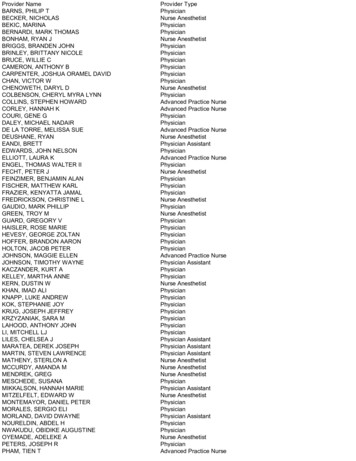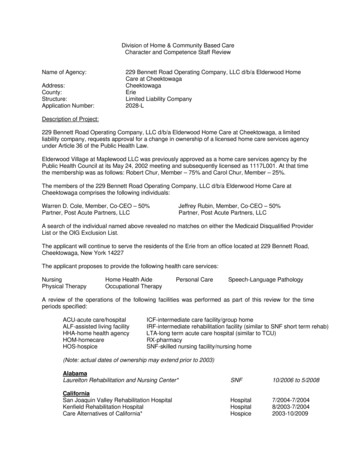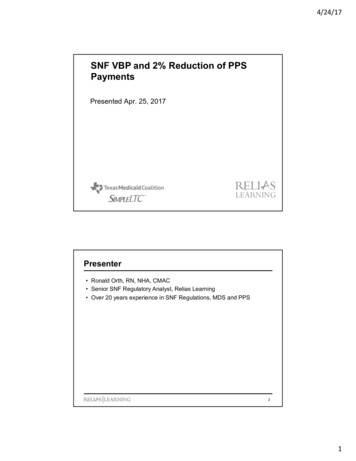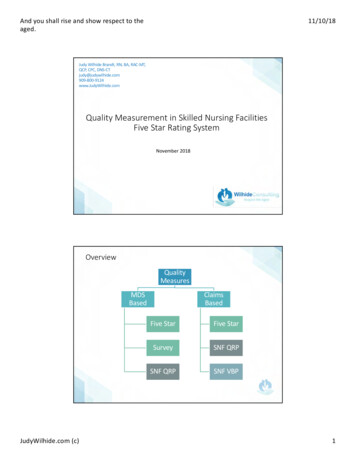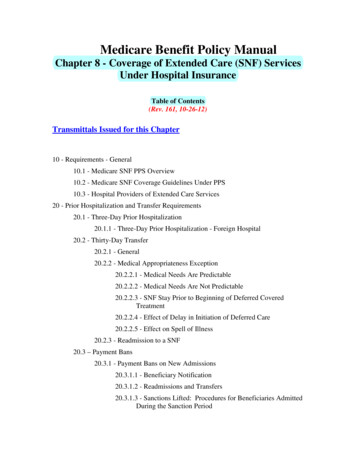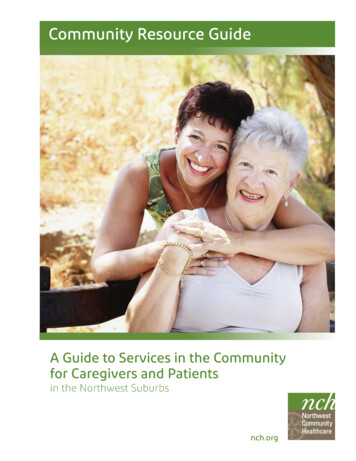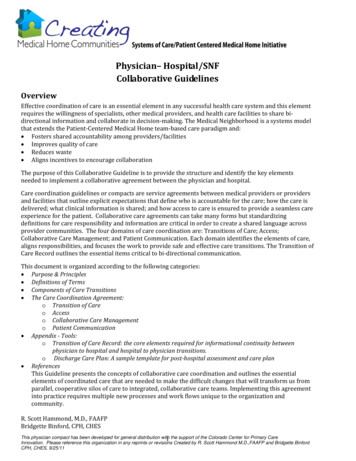
Transcription
Physician– Hospital/SNFCollaborative GuidelinesOverviewEffective coordination of care is an essential element in any successful health care system and this elementrequires the willingness of specialists, other medical providers, and health care facilities to share bi‐directional information and collaborate in decision‐making. The Medical Neighborhood is a systems modelthat extends the Patient‐Centered Medical Home team‐based care paradigm and: Fosters shared accountability among providers/facilities Improves quality of care Reduces waste Aligns incentives to encourage collaborationThe purpose of this Collaborative Guideline is to provide the structure and identify the key elementsneeded to implement a collaborative agreement between the physician and hospital.Care coordination guidelines or compacts are service agreements between medical providers or providersand facilities that outline explicit expectations that define who is accountable for the care; how the care isdelivered; what clinical information is shared; and how access to care is ensured to provide a seamless careexperience for the patient. Collaborative care agreements can take many forms but standardizingdefinitions for care responsibility and information are critical in order to create a shared language acrossprovider communities. The four domains of care coordination are: Transitions of Care; Access;Collaborative Care Management; and Patient Communication. Each domain identifies the elements of care,aligns responsibilities, and focuses the work to provide safe and effective care transitions. The Transition ofCare Record outlines the essential items critical to bi‐directional communication.This document is organized according to the following categories: Purpose & Principles Definitions of Terms Components of Care Transitions The Care Coordination Agreement:o Transition of Careo Accesso Collaborative Care Managemento Patient Communication Appendix Tools:o Transition of Care Record: the core elements required for informational continuity betweenphysician to hospital and hospital to physician transitions.o Discharge Care Plan: A sample template for post hospital assessment and care plan ReferencesThis Guideline presents the concepts of collaborative care coordination and outlines the essentialelements of coordinated care that are needed to make the difficult changes that will transform us fromparallel, cooperative silos of care to integrated, collaborative care teams. Implementing this agreementinto practice requires multiple new processes and work flows unique to the organization andcommunity.R. Scott Hammond, M.D., FAAFPBridgette Binford, CPH, CHESThis physician compact has been developed for general distribution with1 the support of the Colorado Center for Primary CareInnovation. Please reference this organization in any reprints or revisions Created by R. Scott Hammond M.D.,FAAFP and Bridgette BinfordCPH, CHES, 9/25/11
Physician – Hospital/SNF Compact1.2.Purpose To provide optimal health care for our patients. To provide a framework for better communication, coordination and safe transition of carebetween physicians and hospital/emergency/SNF facilities.Principles Safe, effective and timely patient care is our central goal. Effective communication between physicians and hospital/SNF care is essential to providingoptimal patient care and to eliminate the waste and excess costs of health care. Mutual respect is essential to building and sustaining a professional relationship and workingcollaboration. A high functioning medical system of care ensures continuity of care and provides patients withaccess to the ‘right care at the right time in the right place with the right team’. A concept of patient transfer with continuous care (as opposed to the traditional concept ofnon‐coordinated patient discharge) is necessary to ensure informational, relational, andgeographic continuity of care.3.Definitions Patient: a person receiving medical or behavioral health care. For purposes of this agreement,the individual is treated in the context of their life circumstances and in consideration of familyneeds and preferences. Care coordination: the deliberate integration of patient care activities between two or moreparticipants involved in a patient’s care to facilitate the appropriate delivery of health careservices (McDonald, NEJM, 2007). Care Coordinator (CC) – a person who assists all patients and their families by acting as apatient advocate and navigator and providing logistical and informational help to patientsreferred to or from outside medical practitioners or facilities. The CC ensures timely andeffective transfer of patient information and coordinates continuity of care between physicians,healthcare organizations, and community resources. Co‐management ‐ the PCP or specialist actively coordinates care with the emergencydepartment physician/hospitalist and hospital‐based physician or SNF providers andcollaborates on management of all medical disorders, drug therapy, secondary referrals,diagnostic testing, patient education, care teams, monitoring, and patient follow‐up.2This physician compact has been developed for general distribution by the Colorado Center for Primary Care Innovation. Please reference thisorganization in any reprints or revisions. Copyright pending.
Physician – Hospital/SNF Compact Emergency care – medical or surgical care obtained on an urgent or emergent basis. Hospitalist – a dedicated inpatient physician who manages the inpatient care of general adultmedicine patients referred by physicians in the community or for those patients without aprimary physician. Medical Neighborhood – a system of care that integrates primary care physicians withspecialists and the medical community through enhanced, bidirectional communication andcare collaboration on behalf of the patient. Patient‐Centered Medical Home –a community‐based and culturally sensitive model of primarycare that ensures every patient has a personal physician who guides a team of healthprofessionals to provide the patient with accessible, coordinated, comprehensive, andcontinuous health care across all stages of life. Patient Goals – health goals determined by the patient after thorough discussion of thediagnosis, prognosis, treatment options, and expectations taking into consideration thepatient’s psychosocial and personal needs and circumstances. Prepared Patient – an informed and activated patient who has an adequate understanding of hisor her present health condition in order to participate in medical decision‐making and self‐management. Primary Care Physician (PCP) – a generalist whose broad medical knowledge facilitates firstcontact with patients, as well as comprehensive and continuous medical care for those patients. Primary management –the PCP or specialist assumes responsibility as the attending physicianand directs and manages the care of the patient. Secondary referrals – A primary referral is from PCP to a specialist. A secondary referral occurswhen a specialist refers to another specialist. Specialist – a physician with advanced, focused knowledge and skills who provides care forpatients with complex problems in a specific organ system, class of diseases, or type of patient. Technical Procedure – transfer of care to obtain a clinical procedure for diagnostic, therapeutic,or palliative purposes. Transition of Care – an event that occurs when the medical care of a patient is assumed byanother medical provider or facility such as a consultation or hospitalization.4. Components of Care Transitions (see Continuum of Collaborative Guidelinesgraphic) Types of accountability1. Primary management and co‐management with shared care of the patient¾ PCP or specialist assumes responsibility as the attending physician for the care ofthe patient by directing, managing and coordinating the patient's health care team.2. Co‐management3This physician compact has been developed for general distribution by the Colorado Center for Primary Care Innovation. Please reference thisorganization in any reprints or revisions. Copyright pending.
Physician – Hospital/SNF Compact¾ Co‐management with Principal Care for the Disease (Referral) – the emergencydepartment physician, hospitalist, hospital‐based physician, or SNF providerassumes responsibility for the comprehensive management of a patient’s referredmedical/surgical condition. The PCP receives consultation reports and providesinput on secondary referrals¾ Co‐management with Principal Care for the Patient– due to the nature and impact ofthe disease or injury, the emergency department physician, hospitalist, hospital‐based physician or SNF becomes the provider for total care until the crisis ortreatment has stabilized or has been completed. The PCP or specialist remainsactive in bi‐directional information, providing input on secondary referrals, end‐of‐life issues and other defined areas of care. Types of transitions:1. Treat and release2. Admission to Emergency Department¾ From office (PCP or specialist referral)¾ From home or ambulance (self‐referral)¾ From hospital department (diagnostic or out‐patient procedure) or hospital transfer3. Direct Admission to hospital¾ From PCP¾ From Specialist¾ From hospital department (diagnostic or out‐patient procedure) or hospital transfer4. Admission to Outpatient Department¾ Laboratoryo From PCPo From specialist¾ Diagnostic testing and imagingo From PCPo From specialist¾ Procedureso From PCPo From specialist5. Admission to Skilled Nursing Facilities6. Transition to home¾ without home care¾ with home health care4This physician compact has been developed for general distribution by the Colorado Center for Primary Care Innovation. Please reference thisorganization in any reprints or revisions. Copyright pending.
Physician – Hospital/SNF Compact5. Mutual Agreement for Care Management The Mutual Agreement section of the tables reflects the core elements of the MedicalNeighborhood and outlines expectations for both physicians and hospital/SNF providers. The Expectations section of the tables provides flexibility to choose what services can beprovided depending on the nature of your practice and working arrangement with physiciansor hospital/SNF providers. The Additional Agreements/Edits section provides an area to add, delete, or modifyexpectations. After appropriate discussion, the representative provider checks each box that applies to thecommitment of his or her practice. When patients self‐refer to the hospital, processes should be in place to determine the patient’soverall needs and reintegrate further care with the PCP and specialists, as appropriate. During emergency care, processes should be in place to determine the patient’s urgent and/oremergent needs and reintegrate further care with the PCP and specialists, as appropriate. Each provider should agree to an open dialogue to discuss and correct real or perceivedbreaches of this agreement, as well as, on the format and venue of this discussion. Optimally, this agreement should be reviewed periodically.5This physician compact has been developed for general distribution by the Colorado Center for Primary Care Innovation. Please reference thisorganization in any reprints or revisions. Copyright pending.
Transition of CarePhysician – Hospital/SNF CompactMutual AgreementsMaintain accurate, up‐to‐date and readable clinical records.When available and clinically practical, agree to standardized demographic and clinical information formatsuch as the Continuity of Care Record (CCR) or Continuity of Care Document (CCD).Ensure safe and timely transfer of care of a prepared patient.Identify the primary medical provider responsible for care throughout each transition.Provide a dedicated team member to receive information for transition of care, as well as, to provide carecoordination.Shift perspective from that of a discrete event of patient admission or discharge to that of a patient transferwith continuous management (CCGC, n.d.).Develop protocols and policies to ensure safe, effective and efficient transfer of care and establishesperformance standards to monitor.Receive all incoming calls and urgent faxes from receiving team with appreciation.ExpectationsAll PhysiciansEnsure safe transfer to the appropriate care facilityable to handle patient needs.Transfer information as outlined in PatientTransition Record preferably within 30 minutes ofrequest or notification of transition.Order appropriate studies that would facilitate thehospital visit, if possible.In cases of direct admission to the hospital,provides patient with hospital contact informationand expected time frame for admission.Inform patient of need, purpose (specific question),expectations, and goals of the hospital admission orED referral.Ensure patient/family is in agreement withhospital admission/ED referral and hospitalselection.Primary Care PhysicianProvides all patients with wallet cards or otheridentification that lists PCP name, other providers(PAs, NPs, Care Coordinator), and contactinformation.Specialist/Skilled Nursing Facility (SNF)Whenever possible, confers with PCP prior toreferral to hospital or ED; in urgent or emergentsituations, contact is made with the PCP regardingthe referral as soon as possible, preferably on thesame day.HospitalEmergency Department (ED)Makes all attempts to identify PCP and/or specialist.For self‐referred patients, notifies PCP or specialistand obtains pertinent medical information.Contacts the PCP/specialist to determine ifadmission is necessary or if outpatient workup isappropriate.Informs patient of need, purpose, expectations, andgoals of hospitalization or other transfers.Notifies referring provider of secondary referrals.Attempts to honor established provider’s referralpatterns.Sends the Patient Transition Care Record toPCP/specialist within 24 hours.Hospitalist and hospital based physiciansInforms patient of need, purpose, expectations andgoals of hospitalization or other transfers.Obtains pertinent medical information fromPCP/specialist at admission.Determines and/or confirms insurance eligibility.Attempts to honor established provider’s referralpatterns.Reviews documentation sent by PCP and utilizesinformation for making care decisions.Confers with PCP before making difficult caredecisions when possible.Sends a faxed or emailed dischargenotification/summary at the time of discharge andthe complete Patient Transition Record to PCPand/or specialist within 48 hours of discharge.6This physician compact has been developed for general distribution by the Colorado Center for Primary Care Innovation. Please reference thisorganization in any reprints or revisions. Copyright pending.
Physician – Hospital/SNF CompactDischarge Advocate/Care Coordinator for ED andHospitalDetermines and/or confirms insurance eligibility onadmission and for transfers.Aids in any insurance/billing concerns.Ensures that appropriate transition documentationis sent from hospital/ED to PCP/specialist or otherfacility.Communicates with care coordinator at PCP orother facility on care and transition planning.Assesses patient’s functional status, preferences,and determines any care coordination needed toassist with safety and activities of daily living(ADLs) upon transition or discharge.Arranges for community resources needed bypatient, including transportation, assistance withactivities of daily living (ADLs), etc.Additional edits/agreements/notes:7This physician compact has been developed for general distribution by the Colorado Center for Primary Care Innovation. Please reference thisorganization in any reprints or revisions. Copyright pending.
Physician – Hospital/SNF CompactAccessMutual AgreementWhen available and clinically practical, provide a secure email option for communication with establishedpatients and/or providers.A health care team member is made available to the patient, caregiver, and receiving health care team for72 hours after the transfer to discuss any concerns regarding the care plan.Use the preferred mode of communication (phone, fax, email).Provide contact information for urgent/ emergent situations.Provide a list of physicians, hospitalists, and/or providers who agree to compact principles.ExpectationsAll PhysiciansAre readily available to physicians, hospitals, andpatients.Are prepared to respond to urgencies.Provide adequate visit availability.Provide alternate back‐up when unavailable forurgent matters.Primary Care PhysicianArranges on‐call provider to be available 24/7;provides single point of contact for on‐callprovider.Follows‐up with patients who “no‐show” to EDor hospital.HospitalEmergency Department/ Hospitalist and hospital based physiciansWhen referred from the office, notifies PCP of ‘no‐shows’.Provides patient with reasonable wait time beforebeing evaluated by a medical provider.HospitalEnsures transition and admittance to the hospital iscoordinated and as timely as possible.Allows PCP access to necessary treatmentinformation outside of the transition care record, ifrequested.Discharge Advocate/Care CoordinatorArranges convenient hours and contact informationfor patient and physician.Facilitates access to necessary patient information.Additional edits/agreements/notes:8This physician compact has been developed for general distribution by the Colorado Center for Primary Care Innovation. Please reference thisorganization in any reprints or revisions. Copyright pending.
Physician – Hospital/SNF CompactCollaborative Care ManagementMutual AgreementDefine responsibilities between PCP, specialist, hospital/SNF, and patient.Clarify who is responsible for specific elements of care (drug therapy, referral management, diagnostic testing,care teams, patient calls, patient education, monitoring, follow‐up).Maintain competency and skills within scope of work and standard of care.Give and accept respectful feedback when expectations, guidelines, or standard of care are not met.Agree on type of care that best fits the patient’s needs and preferences.Share data/reports with patient care team (Primary Care Physician, Hospital, Specialist/SNF) providers in atimely manner including pertinent consultations or care plans from other care providers.ExpectationsAll PhysiciansHospitalPrimary Care PhysicianManages the medical problem to the extent of thephysician’s scope of practice, abilities and skills.Follows standard practice and evidence‐basedguidelines.Resumes care of patient as outlined by hospital/SNFprovider, assumes responsibility and incorporatescare plan recommendations into the overall care ofthe patient.Emergency Department/ Hospitalist and hospital based physiciansReviews information sent by PCP and addressesprovider and patient concerns.Clarifies with the patient of their relationship aspart of their care team with the PCP or specialistConfers with PCP before ordering additionalservices outside practice guidelines when possible.Obtains proper prior authorization.Confers with PCP before refers tosecondary/tertiary specialists for problems and,when appropriate, uses a preferred list to referwhen problems are outside PCP scope of care.Notifies the PCP office or designated personnel ofmajor interventions, emergency care orhospitalizations.Prescribes pharmaceutical therapy on discharge inline with insurance formulary with preference togenerics when available and if appropriate topatient needs.Provides useful and necessaryeducation/guidelines/protocols to PCP, as needed.Specialist/SNFConfers with PCP before referring tosecondary/tertiary specialists for problems withinthe PCP scope of care and, when appropriate, uses apreferred list to refer when problems are outside PCPscope of care. Obtains proper prior authorizationwhen needed.Notifies the PCP office or designated personnel ofmajor interventions, emergency care or re‐hospitalizations.Prescribes pharmaceutical therapy in line withinsurance formulary with preference to genericswhen available and, if appropriate, to patient needs.Provides useful and necessaryeducation/guidelines/protocols to PCP, as neededDischarge Advocate/Care CoordinatorCoordinates information between hospital and PCPand/or specialist or other facilities and facilitatescollaboration in preparation of care plan.Assesses functional status, needs of and supportfor the patient prior to discharge and provideswritten care plan to patient, family and providersaccording to their preferences.Ensures primary medical provider has knowledgeof and access to needed support systems.Provides PCP care coordinator with updates onpatient status when major changes occur or other9This physician compact has been developed for general distribution by the Colorado Center for Primary Care Innovation. Please reference thisorganization in any reprints or revisions. Copyright pending.
Physician – Hospital/SNF Compactcare needs present.Performs hand‐off phone call with PCP carecoordinator.Additional edits/agreements/notes:10This physician compact has been developed for general distribution by the Colorado Center for Primary Care Innovation. Please reference thisorganization in any reprints or revisions. Copyright pending.
Physician – Hospital/SNF CompactPatient CommunicationMutual AgreementConsider patient/family preferences and choices in care management, diagnostic testing and treatment plan.Provide to and obtain informed consent from patient according to community standards.Explore patient issues on quality of life in regards to their specific medical condition and share thisinformation with the care team.Participate with patient care team as needed.ExpectationsPhysicianHospitalPrimary Care PhysicianExplains, clarifies, and secures mutualagreement with patient on recommended careplan.Assists patient in identifying his or hertreatment goals.Identifies whom the patient wishes to beincluded in his or her care team.Educates patient on importance of notifyinghospital/SNF providers of PCP designation(through use of wallet card, etc.).Emergency DepartmentInforms patient of diagnosis, prognosis, and follow‐uprecommendations.Provides educational material and resources to patientand educates patient of the importance tocommunicate with PCP regarding the ED visit.Provides procedures to follow if a problem arises withdischarge plan.Recommends appropriate follow‐up with PCP and/orspecialist.Specialist/SNFInforms patient of diagnosis, prognosis andfollow‐up recommendations.Provides educational material and resources topatient when appropriate.Recommends appropriate follow‐up with PCP.Is available to the patient to discuss questions orconcerns regarding the consultation or theircare management.Hospitalist and hospital based physiciansInforms patient of diagnosis, prognosis, and follow‐uprecommendations.Provides educational material and resources to patientwhen appropriate.Recommends appropriate follow‐up with PCP.Is available to the patient or family to discussquestions or concerns regarding the consultation ortheir care management.Provides procedures to follow if a problem arises withdischarge planEducates patient of importance of communication withPCP regarding hospital visit.Discharge Advocate/Care CoordinatorEnsures that patient communication preferences areknown by providers.Ensures that patient cultural considerations areascertained and known by providers; provideassistance and education to provider on culturalconsiderations, if needed.Monitors and improves transition process throughsatisfaction surveys of patients and physicians.Additional edits/agreements/notes:11This physician compact has been developed for general distribution by the Colorado Center for Primary Care Innovation. Please reference thisorganization in any reprints or revisions. Copyright pending.
Physician – Hospital/SNF Compact6. AppendixA. Physician to Hospital Transition Care Record1. Demographics: Patient ‐‐Patient name, DOB, contact and insurance information Practice ‐‐ PCP designation, referring provider and contact information.2. Clinical Note: Primary complaint and a clear clinical reason for patient transfer Key physical findings and relevant notes and test results Assessment/Diagnosis ‐‐ ICD‐9 code3. Clinical Data: problem listmedical and surgical historycurrent medicationimmunizationsallergy/contraindication listpertinent labs and diagnostics testspatient cognitive statuspatient functional statuscaregiver statusadvanced directiveslist of other providers, specialists, care team4. Admission/Treatment or Transfer Orders5. Type of transitions of care. Primary managementCo‐management Principal care of the Disease Principal care of the Patient Technical procedurea. Communication and follow‐up preference – phone, letter, fax or e‐mail12This physician compact has been developed for general distribution by the Colorado Center for Primary Care Innovation. Please reference thisorganization in any reprints or revisions. Copyright pending.
Physician – Hospital/SNF CompactB. Hospital to Physician Transition Care Record1. Demographics Patient‐‐ name, identifying and contact information, insurance information, PCPdesignation.2. Facility details – Hospital name, attending physician with contact numbers andcommunication preference – phone, letter, fax or e‐mail,3. Date(s) of hospitalization or Emergency Department visit4. Diagnoses (ICD‐9 codes) Admitting diagnosis Discharge and secondary diagnoses.5. Care team ‐ list of consultants and community resources involved in hospital care orreferral after hospital discharge6. Discharge summary Course of illness or treatment Clinical Data – problem list, complete medication list noting new medications,immunizations given, labs and diagnostic tests with list of pending results. Procedures – summarize procedure details, findings and recommendations. Condition on discharge (including cognitive level) Disposition (LTC, Home Health, Home, etc.)7. Recommendations – communicate recommendations for further diagnostictesting/imaging, additional referrals and/or treatment. Develop an evidence‐based careplan with responsibilities and expectations of the hospital and responsible physician thatclearly outline: Medication or medical equipment changes, and monitoring responsibility. Recommended timeline of future tests, procedures, secondary referrals andcoordination of community resources and who is responsible to institute, coordinate,follow‐up and manage the information. Patient goals, functional status, level of activation, support issues, input and educationprovided on disease state and management8. Follow‐up status – Specify time frame for next appointment to primary physician and/orspecialists.13This physician compact has been developed for general distribution by the Colorado Center for Primary Care Innovation. Please reference thisorganization in any reprints or revisions. Copyright pending.
Physician – Hospital/SNF CompactC. Discharge Care PlanPatient:Diagnosis:Hospitalization Dates:Care Team:PCP:Transition to:Discharge Summary sent:To:Date:Physician appointment: Date:StatusLaboratory/Diagnostic tests pending:Test:Test:Test:Information NeededFunctional Status Medical Status Self‐care Ability Social SupportDate: Disposition Communication DME Referral Lab orders Short Term GoalLong term goalADL assessmentTransportation issuesDiagnosisCo‐morbid conditionsPrognosisMedication ReviewAllergy ReviewAdvance DirectivesCurrent Ability andconfidenceEducational needsPrimary CaregiverAbility/willingness togive careCommunity supportPrior residenceCurrent residenceFuture residenceLanguage needsHealth beliefsCurrent needsVendorName, specialty anddate recommendedHospital orders anddate recommendedCurrent Functional StatusCognitiveIndependentRequires assistUnableDressIndependentRequires assistUnableBathingIndependentRequires assistUnableToiletingIndependentRequires assistUnableBathingIndependentRequires assistUnable14This physician compact has been developed for general distribution by the Colorado Center for Primary Care Innovation. Please reference thisorganization in any reprints or revisions. Copyright pending.
Physician – Hospital/SNF Compact7. References1. American Academy of Family Physicians. (2009, April). Hospitalists. Retrieved January 13, 2010, fromAAFG Guidelines for Interaction in "Hospitalist" Models ‐ Communication Between the ReceivingInpatient Care Management Physician and the Referring Primary Care Physician: www.aafp.org.2. Bodenheimer, Thomas. (2008, March). Coordinating Care – A Perilous Journey Through the Health CareSystem. New England Journal of Medicine.3. California Healthcare Foundation. (2010, October). The Post‐Hospital Follow‐up Visit: A PhysicianChecklist to Reduce Readmissions.4. Colorado Clinical Guidelines Collaborative. (n.d.). Hospital Sub‐Group Overview. Patient‐CenteredMedical Home .5. HMO Workgroup on Care Management. (2004, February). One Patient, Many Places: Managing HealthCare Transitions. Washington, DC.6. Taylor EF, Lake T, Nysenbaum J, Peterson G, Meyers D. (2011, June). Coordinating care in the medicalneighborhood: critical components and available mechanisms. White Paper (Prepared by MathematicaPolicy Research under Contract No. HHSA290200900019I TO2). AHRQ Publication No. 11‐0064.Rockville, MD: Agency for Healthcare Research and Quality.15This physician compact has been developed for general distribution by the Colorado Center for Primary Care Innovation. Please reference thisorganization in any reprints or revisions. Copyright pending.
experience for the patient. Collaborative care agreements can take many forms but standardizing definitions for care responsibility and information are critical in order to create a shared language across provider communities. The four domains of care coordination are: Transitions of Care; Access;
